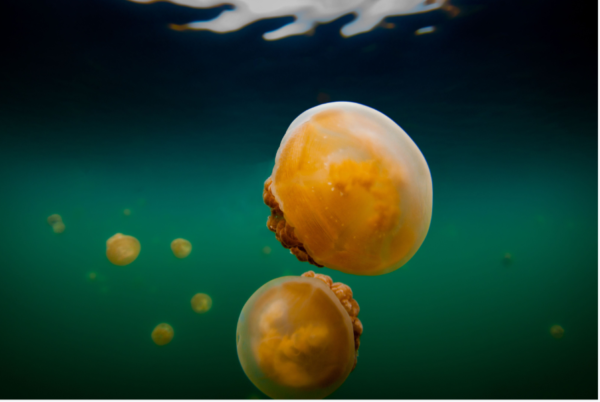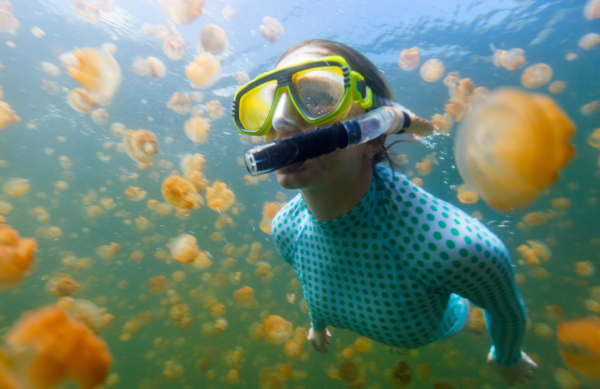In a quiet corner of our planet sits Eil Malk, one of some 250 mostly uninhabited islands found in the Southern Lagoon of Palau, located between Koror and Peleliu. This densely wooded island is only 6km long and 4.5km wide, devoid of human settlements, although explorers did find the remnants of an abandoned village there dating back over 500 years.
There are a number of small lakes on the island, but one stands out as more famous than the rest: Jellyfish Lake, located near to the east coast. Connected to the ocean through fissures and tunnels in an ancient reef, this body of water is around 12,000 years old, which was estimated by its 30-metre depth. It also boasts conditions different to the rest of the lagoon, which has ultimately affected the species living there.

As one would expect from the name, this lake is home to two species of jellyfish, millions of which migrate across it daily. The Golden Jellyfish that inhabit the waters of the lake are closely related to the wider-spread Spotted Jellyfish of the lagoon around them, yet are classified as a different subspecies due to how they have evolved within the lake’s confines. They have lost both their spots and their clubs, an appendage found on the lagoon jellyfish.
The Golden Jellyfish’s neighbours in the lake, the Moon Jellyfish, are so-called as they head to the surface of the lake when night falls to feed on the copepods found there. During the night, as the Moon Jellyfish rise to the surface all across the lake, the Golden Jellyfish can be found at the western end within the basin there, making repeated vertical journeys between the surface and the chemocline, where they acquire nitrogen and other nutrients. While their neighbours do not have a set migration pattern, the Golden Jellyfish move to the eastern basin during early morning and back again in the afternoon.
This interesting pattern is theorised as being an adaptive or evolutionary change, driven by the fact that there are anemones located in the eastern regions of the lake that eat jellyfish. The Golden Jellyfish instinctively avoid shadows and so, as they move across the lake during the day, they also manage to stay in the light and avoid the anemones.
In 1998, there was a serious decline in the Golden Jellyfish population within Jellyfish Lake and, by December, it was believed that they had all died out. The cause of this disaster was determined to be an El Nino weather event that raised the water temperature and killed the symbiotic algae within the jellyfish, which they rely on to survive. However, in January 2000, scientists observed Golden Jellyfish back in the lake and, by May 2012, the population returned to pre-decline levels.
The Moon Jellyfish proved to be much more resilient, exhibiting some damage following the weather event in 1998, but their numbers remained steady.
It was inevitable that eventually, tourism would affect the lake and its peaceful inhabitants. Early attempts at scuba diving excursions proved to have dangerous ramifications for both the jellyfish and divers; bubbles from the scuba tanks harmed the jellyfish when they collected beneath their bell-like bodies, while an anoxic layer containing high levels of hydrogen sulphide was discovered at a depth of 15 metres, which could be absorbed through the skin of divers and may lead to death.
While scuba diving is now prohibited, snorkelling trips are a popular activity for visitors, who obtain access passes from neighbouring Koror and make the 45-minute boat ride to Eil Malk.

Although both species of jellyfish living in the lake have stinging cells, they are not powerful enough to seriously harm humans. This allows visitors to swim freely amongst the myriad bobbing inhabitants for a truly unique experience. The only other consideration for those heading into the waters of Jellyfish Lake are saltwater crocodiles that are native to Palau, although they are not considered a threat to humans.
Safe within their home on Eil Malk, it is expected both the Golden and Moon Jellyfish will continue to thrive alongside one another. Hopefully, they shall also thrive alongside the humans that come to view them, as long as visitors remain respectful and the push from tourism does not become too great.







